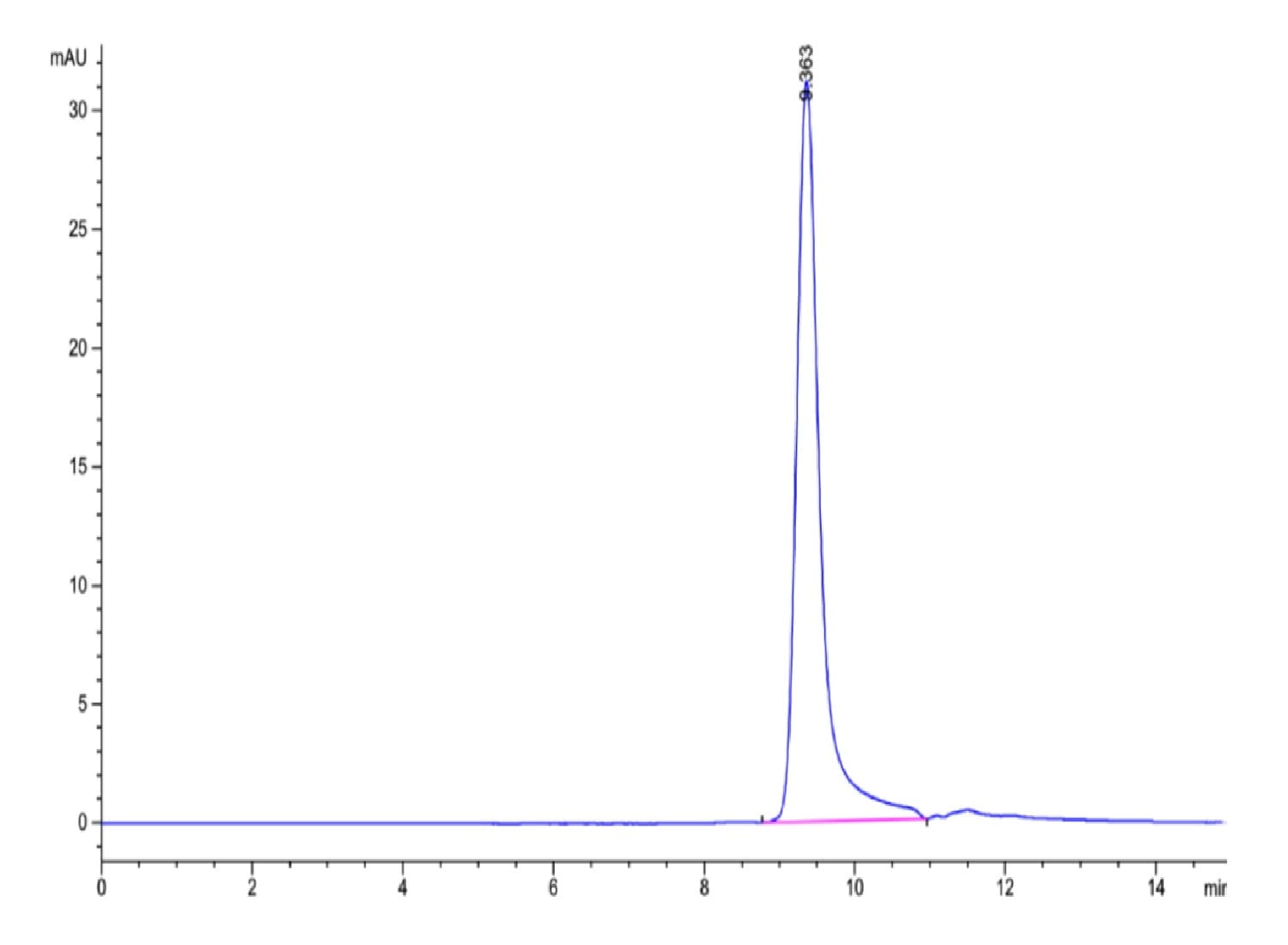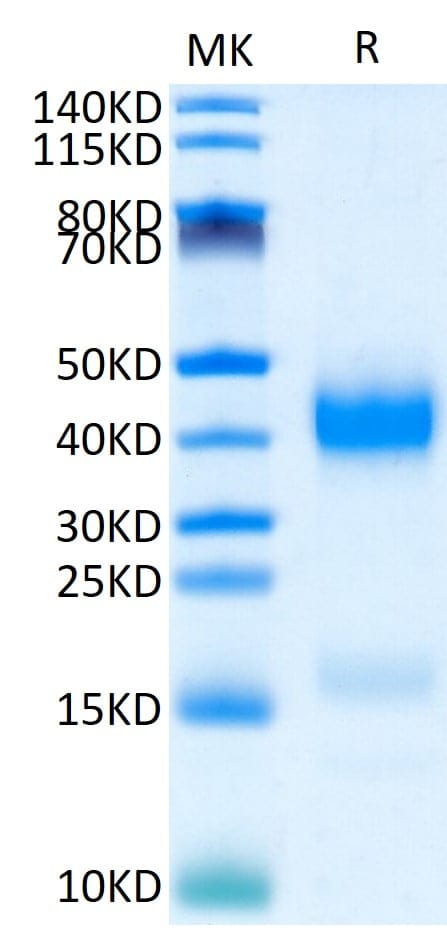| Weight | 1 lbs |
|---|---|
| Dimensions | 9 × 5 × 2 in |
| accession | P20160 |
| express system | HEK293 |
| product tag | C-His |
| purity | > 95% as determined by Tris-Bis PAGE;> 95% as determined by HPLC |
| background | Heparin-binding protein (HBP), also known as cationic antimicrobial protein 37 (CAP37) and Azurocidin, is a member of the serine protease family that includes Cathepsin G, neutrophil elastase (NE), and proteinase 3 (PR3). This is a neutrophil granule-derived antibacterial and monocyte- and fibroblast-specific chemotactic glycoprotein. Binds heparin. The cytotoxic action is limited to many species of Gram-negative bacteria; this specificity may be explained by a strong affinity of the very basic N-terminal half for the negatively charged lipopolysaccharides that are unique to the Gram-negative bacterial outer envelope. |
| molecular weight | The protein has a predicted MW of 25.3 kDa. Due to glycosylation, the protein migrates to 38-50 kDa based on Tris-Bis PAGE result. |
| available size | 100 µg, 500 µg |
| endotoxin | Less than 1EU per μg by the LAL method. |
Human Azurocidin/CAP37/AZU1/HBP Protein 4681
$180.00 – $600.00
Summary
- Expression: HEK293
- Pure: Yes (HPLC)
- Amino Acid Range: Ile27-Pro250
Human Azurocidin/CAP37/AZU1/HBP Protein 4681
| protein |
|---|
| Size and concentration 100, 500µg and liquid |
| Form Liquid |
| Storage Instructions Valid for 12 months from date of receipt when stored at -80°C. Recommend to aliquot the protein into smaller quantities for optimal storage. Please minimize freeze-thaw cycles. |
| Storage buffer Shipped with dry ice. |
| Purity > 95% as determined by Tris-Bis PAGE |
| target relevance |
|---|
| Heparin-binding protein (HBP), also known as cationic antimicrobial protein 37 (CAP37) and Azurocidin, is a member of the serine protease family that includes Cathepsin G, neutrophil elastase (NE), and proteinase 3 (PR3). This is a neutrophil granule-derived antibacterial and monocyte- and fibroblast-specific chemotactic glycoprotein. Binds heparin. The cytotoxic action is limited to many species of Gram-negative bacteria; this specificity may be explained by a strong affinity of the very basic N-terminal half for the negatively charged lipopolysaccharides that are unique to the Gram-negative bacterial outer envelope. |
| Protein names Azurocidin (Cationic antimicrobial protein CAP37) (Heparin-binding protein) (HBP) (hHBP) |
| Gene names AZU1,AZU1 |
| Protein family Peptidase S1 family, Elastase subfamily |
| Mass 9606Da |
| Function This is a neutrophil granule-derived antibacterial and monocyte- and fibroblast-specific chemotactic glycoprotein. Binds heparin. The cytotoxic action is limited to many species of Gram-negative bacteria; this specificity may be explained by a strong affinity of the very basic N-terminal half for the negatively charged lipopolysaccharides that are unique to the Gram-negative bacterial outer envelope. It may play a role in mediating recruitment of monocytes in the second wave of inflammation. Has antibacterial activity against the Gram-negative bacterium P.aeruginosa, this activity is inhibited by LPS from P.aeruginosa. Acting alone, it does not have antimicrobial activity against the Gram-negative bacteria A.actinomycetemcomitans ATCC 29532, A.actinomycetemcomitans NCTC 9709, A.actinomycetemcomitans FDC-Y4, H.aphrophilus ATCC 13252, E.corrodens ATCC 23834, C.sputigena ATCC 33123, Capnocytophaga sp ATCC 33124, Capnocytophaga sp ATCC 27872 or E.coli ML-35. Has antibacterial activity against C.sputigena ATCC 33123 when acting synergistically with either elastase or cathepsin G. |
| Subellular location Cytoplasmic granule membrane ; Peripheral membrane protein ; Cytoplasmic side. Note=Localizes to azurophil granules of neutrophil granulocytes. Also called primary granules, these specialized lysosomes of the neutrophil formed early during promyelocyte development store antibacterial proteins and peptides. |
| Post-translational modification Cleavage of the N-terminal propeptide which is composed of 7 amino acids occurs in two steps. The initial cleavage of 5 amino acids is followed by the cleavage of a dipeptide to produce the mature form. |
| Target Relevance information above includes information from UniProt accession: P20160 |
| The UniProt Consortium |
Data
 |
| The purity of Human Azurocidin is greater than 95% as determined by SEC-HPLC. |
 |
| Human Azurocidin on Tris-Bis PAGE under reduced condition. The purity is greater than 95%. |
Publications
Publications
| pmid | title | authors | citation |
|---|---|---|---|
| We haven't added any publications to our database yet. | |||
Protocols
| relevant to this product |
|---|
Documents
| # | ||
|---|---|---|
| Please enter your product and batch number here to retrieve product datasheet, SDS, and QC information. | ||














